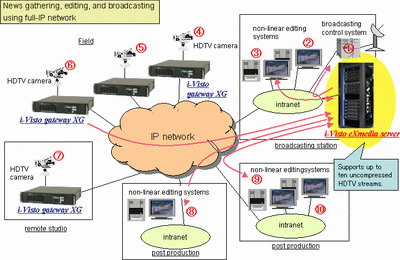World's First Video Stream Server Capable of Handling up to Ten Uncompressed HDTV Video Streams
Nippon Telegraph and Telephone Corp. today announced a PC cluster-based, video stream product, named the i-Visto eXmedia server, which can simultaneously handle up to ten 1.5-Gbps of uncompressed high definition television (HDTV) video streams in real-time using an IP network. The i-Visto eXmedia server is intended for professional use in the broadcasting industry. The product's high performance will enable broadcast professionals to simplify and improve the sharing of video over IP networks.
NTT Network Innovation Laboratories developed a new PC clustering(1) process that integrates multiple general purpose PCs into a video stream server that can handle more than one gigabit of video streams using a commercially available, low-delay interconnection network.
Based on NTT's PC clustering approach, the i-Visto eXmedia server can simultaneously handle up to ten, uncompressed HDTV video streams using IP, for a combined throughput of 15 Gbps. This processing capability will support up to ten users who can simultaneously retrieve or store uncompressed HDTV video materials or can concurrently process 100 high-definition, digital VTR-quality materials.
When combined with the i-Visto gateway XG(2), another NTT product that serves the broadcasting industry, it functions as a complete system that integrates transmission, storage, and delivery of uncompressed HDTV video streams over an IP network. The handling of uncompressed video materials eliminates the need for additional hardware to compress and decompress video data. It also eliminates video quality degradation caused by repeated compression and decompression operations.
The i-Visto eXmedia server enables broadcasting professionals to share video materials among remote studios or transmit video materials from the field to an editing studio using IP. An extensive video processing network system can be easily configured to support remote video sharing.

Traditional Fibre Channel(3) -based file sharing systems have posed two challenges. To begin with, it is difficult to extend the Fibre Channel, which connects the disk and client, such as a non-linear editing system, beyond 10 kilometers. Secondarily, these systems require the use of 2 separate networks: an IP network to control and the Fibre Channel for transferring the data. On the other hand, the i-Visto eXmedia server only needs an IP network and does not have any distance limitations. Many kinds of common IP/PC-based systems such as the World Wide Web, database systems, and PC or workstation-based, non-linear editing systems can be included in the network.
Development Background
Due to continuous improvements in Internet technology, network bandwidth availability for users is increasing from megabit per second to gigabit per second. At the same time, the broadcasting industry is witnessing digital HDTV replace traditional analog TV. These trends point to a foreseeable increased demand for transmitting high quality HDTV video over IP networks.
Accordingly, NTT has been advancing research on high quality video transmission and storage over ultra high speed IP networks. As part of this initiative, NTT Network Innovation Laboratories has been developing PC/IP-based HDTV transmission systems, resulting in the unveiling of the i-Visto eXmedia server. Following are additional technical features of the product.
Technical Features
1. Cost-effective
An exceptionally cost-effective InfiniBand(4) technology is used as an interconnection network. Any commercial RAID system(5) can be used to incorporate with the i-Visto eXmedia server, enabling users to choose a RAID system based on their own existing requirements such as reliability, maintainability, and pricing.
2. Scalability
The cluster size can be changed according to individual requirements for transmission performance. Moreover, the storage capacity can be enlarged, without capacity limitations, by installing additional RAID systems using a storage area network (SAN).
3. Distributed RAID
Every video stream is divided into fragments and stored in different RAID systems. This equalizes the disk access load of each RAID system regardless of the video access patterns.
NTT Laboratories together with NTT Group companies will incorporate customer feedback into the i-Visto eXmedia server before its planned availability in Q4 of 2005. Meanwhile, NTT Laboratories will continue to enhance the server's system performance with the goal of achieving full-IP video delivery networks, enabling people to view high quality video materials at any time, in any place.
Terminology
(1) PC clustering
A technique in which multiple computers are interconnected and work together as a single system.
(2) i-Visto gateway XG
i-Visto gateway XG is an IP-based, high quality video (e.g., HDTV) transmission system developed by NTT. The transmission delay is less than the time taken to display one HDTV video frame, which does not present any problems in practical use.
(3) Fibre Channel
An I/O specification that connects storage systems with servers and other storage systems. It is commonly used in constructing a SAN that connects several storage systems and enables servers to share these storage systems.
(4) InfiniBand
Specified by the InfiniBand Trade Association, InfiniBand is an interconnect or I/O architecture that connects servers with remote storage and networking devices and other servers. The current specification provides a performance range of 2.5 to 30 Gbps per link.
(5) RAID system
Short for redundant array of independent (or inexpensive) disks. RAID is a category of disk drives that combine multiple hard disk drives for improved fault tolerance and performance.















